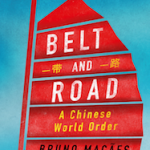China’s One-Belt One-Road, later rechristened the Belt and Road Initiative (BRI), is easily one of the most discussed and most controversial subjects in international affairs. It purportedly started out as an infrastructure project, but is now being increasingly seen as a push towards creating a China-centred global economic system. Belt and Road: A Chinese World Order, by Bruno Maçães, who is the author also of The Dawn of Eurasia (Yale University Press, 2018), and a senior fellow at China’s Renmin University, tries to look at the many different dimensions of the project – how it originated, what it seeks to do and responses to it across the world. This book comes at an important time: the BRI was unveiled in 2013, and ever since, significant investments have taken place in South, South-East and Central Asia and Africa and are now taking material effect.
The book starts with an explanation of what the BRI is about – how the concept developed, why China felt the need for it and how it has tried to sell the idea to the rest of the world. It then goes on to examine its components and impact on the world economy. The author has avoided judging the project upfront, but his listing of facts and events leaves little doubt about China’s intentions to dominate the world. “The Belt and Road is the name for a global order infused with Chinese political principles and placing China at its heart,” the author says – a statement which best captures the ambitious scale of the project. This new global order will have Chinese (state-owned) multinationals monopolising global supply chains, the Chinese political system (undemocratic) as an alternative to liberal democracy and a Chinese narrative dominating culture as well. The author points out that China has claimed that the project is purely economic in intent but such claims have been belied by its own efforts to promote the initiative. Other countries will take only a secondary position in its scheme of things. China’s aim to dominate global supply chains is led by state- owned enterprises – with explicit state backing. The author cites the example of a contract for large container ships going to a Chinese shipyard over a South Korean rival because the Chinese offered preferential access to dozens of ports and container terminals it owns worldwide. Another dimension to such economic domination is that the European Union finds it can no longer issue statements on China’s human rights violations since its poorer members have received large investments from China.
The economic footprint may also lead to a military presence of which the author points out various instances, including the creation of Chinese versions of the infamous U.S. security contractor, Blackwater, which showed the shadowy aspects of the military’s use of private security.
Such actions have resulted in world opinion turning against the BRI The global pushback now includes the U.S. trade war as also Germany disallowing the acquisition of Leifeld Metal Spinning AG by a Chinese firm on national security grounds.
Going by the evidence already in the public domain and brought out in the book, these seem natural responses to an aspiring hegemon. In its original form, the first phase of the BRI was supposed to be completed by 2021, while the entire project, with its railway lines, ports and roads was to be ready by 2049. This seems unlikely now.
Maçães has also tried to examine BRI from the Indian perspective – and the risks and possible opportunities it offers to participate. India risks being relegated to being ‘just another market’, which is how China seems to view most of the world. For BRI to succeed, India’s cooperation is vital because the Indian market is a prized one for China. Since China has defined BRI as a ‘constitutional principle’, its ruling elite has not taken very kindly to India’s opposition, voiced from the time the project was announced. China’s actions in Doklam can thus be seen as a move to coerce India into falling in line. Such coercion and how China views India in a post-BRI world are aspects about which policy- and opinion-makers in India need to draw their own conclusions.
In all, Maçães provides a bird’s-eye view of BRI, its scope and ambition. His book neither goes into too much detail nor does it provide vast amounts of data: it is a useful read for anyone interested in the project.
Belt and Road: A Chinese World Order By Bruno Maҫᾶes (Penguin RandomHouse)
Amit Bhandari is Fellow, Energy and Environment Studies, Gateway House.
This review was exclusively written for Gateway House: Indian Council on Global Relations. You can read more exclusive content here.
For interview requests with the author, or for permission to republish, please contact outreach@gatewayhouse.in.
© Copyright 2019 Gateway House: Indian Council on Global Relations. All rights reserved. Any unauthorized copying or reproduction is strictly prohibited.


